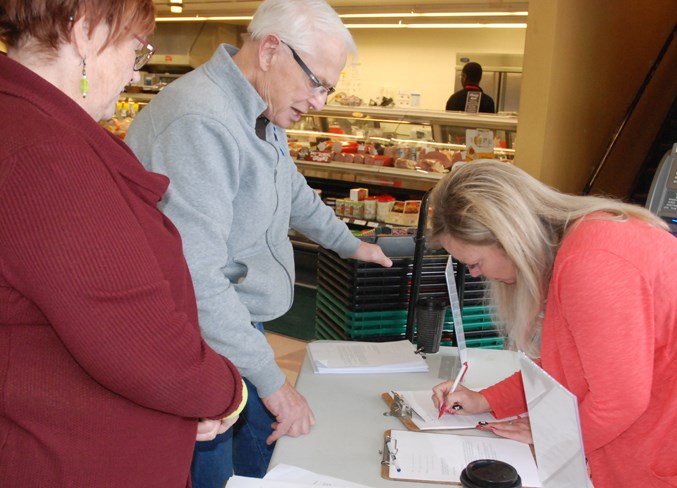A business case to build a cardiac catheterization lab at the Red Deer Regional Hospital Centre, which would help patients in Central Alberta, is being prepared for presentation to the provincial government.
Alberta Health Services Central Zone medical director Dr. Daniel Edgcumbe told the Round Up recently that plans are being considered for the addition of the service, which is currently only available in Calgary and Edmonton.
According to numerous physicians at the Red Deer hospital’s division of cardiovascular sciences, the delay in receiving care caused by additional transfers could potentially produce a detrimental outcome for patients in Central Alberta who suffer from heart complications.
Cardiac catheterization is a standard interventional procedure that has been used since the 1980s and diagnoses as well as treats coronary artery disease, reads a letter signed by nine doctors lobbying the provincial government for change
“For years, there has been a desire to offer the coronary angiography services at the Red Deer Regional Hospital, with community support and funds raised to build a cardiac catheterization lab in the facility,” it reads.
However, the same level of support from AHS and the provincial government has yet to materialize, and patients are on a daily basis transferred from Red Deer to receive the standard cardiac test, it adds.
“Heart attacks are a time-sensitive matter. With the inherent delay in getting to the cardiac catheterization lab, patients in Central Alberta suffer more severe heart damage,” wrote the physicians.
“Central Albertans are 60 per cent more likely to die and 30 per cent more likely to be re-hospitalized compared to patients from Calgary or Edmonton.”
Having a cardiac catheterization lab in Red Deer, they contend, would substantially improve outcomes in this part of the province that would subsequently represent a cost savings since patients would no longer require expensive ground or air ambulance transportation to Calgary or Edmonton.
Bergen-area resident John Regehr is among the Central Albertans who, despite numerous delays in treatment for a cardiac condition, pulled through.
Even though he is a non-smoker who prides himself on staying in shape — a treadmill in the basement ensures he can do a daily walk even in bad weather — Regehr developed a heart problem.
“I was one of the fortunate ones who lasted the trip to Edmonton,” he said.
“But for some people, that trip is too much and they don’t survive.”
In October 2016, a blockage in his arteries resulted in an initial middle-of-the-night trip to the Sundre Hospital and Care Centre, from where he was sent to the Red Deer Regional Hospital Centre after being stabilized. But the trip was far from over, as the life-saving treatment he required was only available in Calgary or Edmonton. He eventually received six stents to help clear the blockage at the Royal Alexandra Hospital in Edmonton.
“What they do is go through your wrist, and they go up into where the blockage is and put a stent in there,” which he described as essentially a small plastic pipe that opens up the artery to restore the blood’s flow.
A major followup heart surgery in August 2017 to repair the damage also resulted in a replacement valve for his aorta. Since then, Regehr reports his condition has remained largely stable.
But when his cardiologist, Dr. Steve Tilley, one of the letter’s nine signatories, encouraged him to consider helping rally support to lobby the province, Regehr decided to get involved by circulating a petition, which to date has garnered about 800 names from Sundre and surrounding area residents.
“I’ve kind of taken this on as a pet project,” he said, adding the only way to convince the government is by presenting a strong case backed by the voice of many people. He plans to spend some time on Nov. 23 at the IGA to get more support.
Once the petition is completed, he plans to present the list of names to MLA Jason Nixon, who in turn will bring it before the legislature to state the case to the health minister.
“We need to have that type of clinic in the Red Deer hospital,” said Regehr, adding it would not only save lives by reducing delays but also alleviate pressure on hospitals in Calgary in Edmonton.
“We recognize access to cardiac services is important,” said Edgcumbe in response to the concerns raised.
“Where we can, we try to make sure that access is close to home.”
AHS works closely with physicians and staff at hospitals throughout the province, a process that helps to develop plans across all of the zones, he said.
The province has been working to produce an interventional cardiac services needs assessment and options analysis report to explore ways to improve cardiac care across Alberta, he said.
While there is a case to be made for the facility in Red Deer, the process is more complicated than just building a lab and also requires taking into consideration staffing the site, he said.
From Alberta Health Services’ perspective, that means working closely with government and physicians to ensure all of the elements are in place, he added.
The government announced $1 million in the coming months to produce a business case for capital planning at the Red Deer hospital, which will include looking at ways to redevelop as well as expand services there, he said.
However, deploying a new lab in Red Deer will only be a part of the equation for cardiac care, he added.
Albertans in the Central Zone are statistically more prone to suffering from cardiac arrest than their city counterparts, he said, citing certain lifestyle factors such as smoking and obesity as culprits.
“We also have to look at ways to reduce the chances of heart disease in the first place.”
Preventive care is at least as important — if not more so — as treatment, he said.
“We’ve got lots of work to do on that.”



